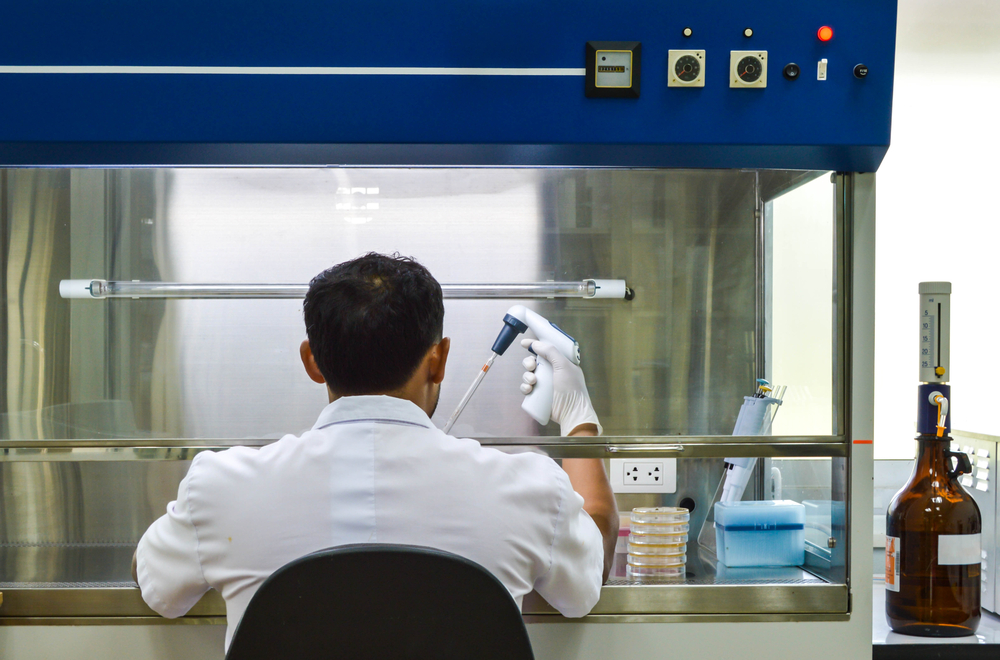Originally published on February 6, 2020, this post has been updated for accuracy and relevancy.
Biological safety cabinets (or BSC’s or biosafety cabinets) are one of the most important tools in modern labs. They provide an enclosed, ventilated space for safely handling hazardous materials.
Most labs with a biosafety level rating have these cabinets to handle samples in. Here, we’ve broken down a few FAQs on BSC decontamination and certification.
Q: Why Do You Need to Decontaminate a BSC?
Answer: Biosafety cabinets are essential units. Ultimately, they keep lab employees safe. Usually, the materials within the cabinets are incredibly dangerous. That’s why they’re in the biosafety cabinet! Humans (and the environment) can’t make contact with them without serious consequences.
Also, lab contamination can happen for several reasons. Possible catalysts are dirty lab coats, unclean workspaces, and poor culture management. Of course, discovering contamination can be problematic. However, specialists such as SEPS can quickly decontaminate it. In addition, any chemicals spills can be easily remedied with simple guidelines.
Additionally, the residue of these substances can build up inside the cabinet. Obviously, this buildup is equally as hazardous as the material itself. Sometimes, lab personnel can mishandle these specimens. Of course, this leads to an accident or spill. In all of these cases, decontamination is a necessary laboratory maintenance service.
Q: How Do You Decontaminate a BSC?
Answer: One of the more archaic methods to decontaminate a biosafety cabinet is bleach. However, no lab should rely on it as a regular cleaning method. Bleach, while a germicide, is corrosive to the steel that most biosafety cabinets are made of. Therefore, you should limit your use of bleach to emergencies only. Basically, you should only use bleach after a sudden spill or accident.
These days, the preferred method for decontamination is chlorine dioxide. At S.E.P.S., this is the method we use most often. Chlorine dioxide is not a liquid, but a gas. It’s validated and approved by NSF/ANSI Standard 49. Additionally, it doesn’t leave behind any residue or harmful byproducts.
There are several other ways to decontaminate and sterilize, like formaldehyde. However, chlorine dioxide is definitely the most popular method.
Q: How Long Does BSC Decontamination Take?
Answer: Chlorine dioxide decontamination takes significantly less time than other decontamination methods. Usually, for one biosafety cabinet, the process takes about 3-4 hours.
If you have several BSC’s in your lab, then we can decontaminate at the same time, which reduces the time. Depending on your lab’s specific circumstances, we are able to work on 6 to 8 BSC’s in one day.
Q: Can We Work in the Lab During Decontamination and Certification?
Answer: Due to the inherent danger of the contaminated BSCs and the chemicals used, the laboratory must be vacant. Signs will be posted clearly, so that your staff will be aware of the lab safety maintenance taking place.
While this may be a short-term inconvenience, the long-term result will pay off. Biological safety cabinets are vital to a research facility’s work. Remediating contaminated BSCs and certifying them enables your lab to run smoothly, reduces future downtime, and makes your workplace safe and compliant.
Q: Why is Lab Equipment Certification Necessary?
Answer: Obviously, decontamination and sterilization is a critical part of biosafety cabinet maintenance. However, another equally crucial aspect is BSC certification.
Certification is an important aspect of running a lab which verifies that your BSC is working safely and effectively. At SEPS, our technicians perform a series of tests to check the performance of biosafety cabinets. Inflow velocity tests, HEPA filter leak tests, smoke visualization, light intensity and sound tests are just a few of the tests performed.
All biological safety cabinets are certified to meet CDC safety and NSF-49 F guidelines and manufacture specifications. Our technicians follow strict standard operating procedures (SOPs), which remain in compliance with Federal and International Safety Guidelines.
Once your equipment is certified, your lab will receive complete documentation for each unit. These documents officially confirm the results of the certification. When you have your cabinet certified, you’re receiving a guarantee that it’s doing its job and all lab personnel are safe.
Conclusion
In any workplace, safety must always remain the highest priority. At SEPS, all of our services are in place to provide labs with the resources they need to keep them as safe and eco-friendly as possible. If your lab uses a biosafety cabinet, decontamination and certification are indispensable services.
